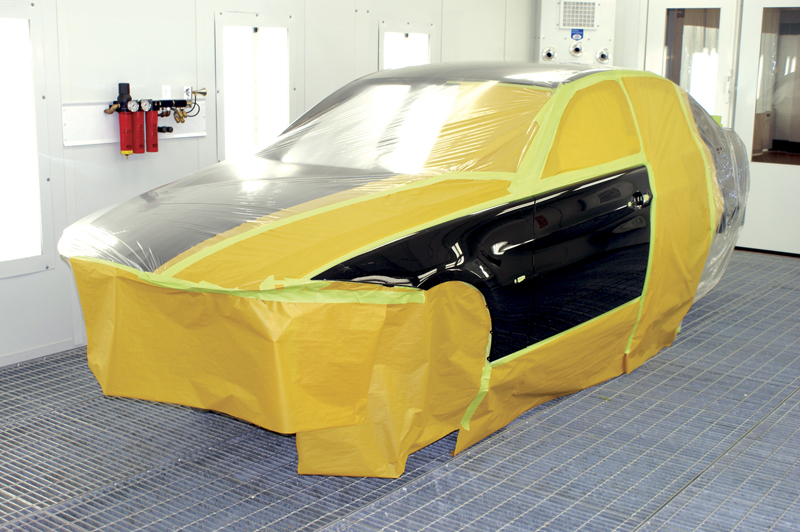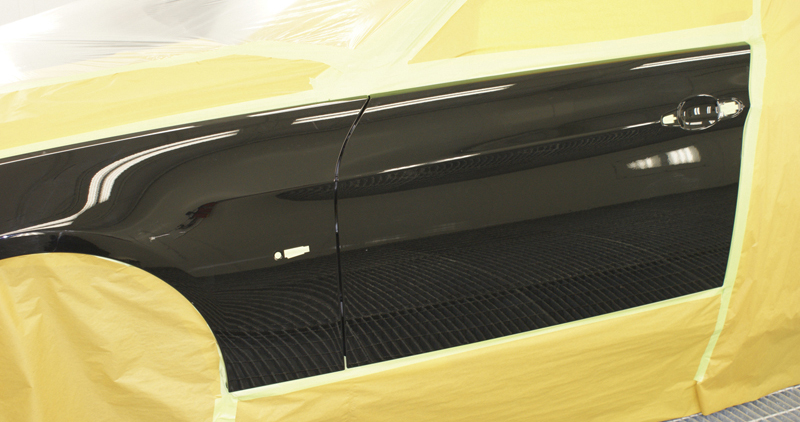
With new technology comes new challenges. Also, with new developments come new methods and procedures. We must keep pace with these changes, or we become obsolete.
Automotive refinishing is no different. In an effort to reduce the negative environmental impact of solvent-borne finishes, chemical companies have invested in new water-borne paint systems. German laws that appeared in the ’90s were further incentive.
BMW built its Spartanburg, South Carolina plant implementing these new water-borne finishes. While they are more environmentally-friendly, and carry some time-saving benefits, they do require different procedures and techniques for application.
In the past, solvent was used as the fluid base for automotive paint finishes. Solvents were mixed with pigments and applied through spray guns to the desired panel. The solvent would evaporate and leave the paint behind. Now, water is the medium through which the paint is sprayed onto the vehicle. As it dries, the water evaporates leaving the paint finish behind. Conventional solvent-borne primers and high-solid clear coats are still the norm, but the color coat is migrating towards water-borne technology.
Benefits of water-borne
Solvent-borne paints need other components to apply paint to a panel. These “Volatile Organic Compounds†(VOCs) are released during the process and contaminate the environment. In the ’90s, the German government mandated the use of water-borne paints, so the technology and development has been happening for the past two decades. New regulations in California have reduced VOC limits, so body shops there need to adopt a low-VOC alternative. Water-borne paints are currently the only paints capable of meeting these low VOC levels. Aside from regulation, there are many other benefits of water-borne paints that will make the transition easier and more cost-effective for collision repair facilities. One of the benefits of these is less overspray, which can reduce paint costs up to 20%. Color matching is also a huge benefit, especially for BMW vehicles.
BMW automobiles use water-borne paints during the manufacturing process. These have different chemical and physical characteristics than what’s available for repair since large qualities are pumped to sprayers on a production line. Also the paint is baked on at 650 deg. F. These characteristics are not compatible with after-market repair, so how can we come as close as possible to the OEM paint finish? BMW has developed ColorSystem to provide a factory-like paint finish for use with aftermarket paint application techniques. Marketing a water-borne paint system may help with customer relations in this age of environmental friendliness. Also, paint supplied by BMW will help maintain vehicle value. Another point is that this will please insurance companies looking to guarantee the repair they just paid for.
BMW’s ColorSystem paint has met or exceeded the quality control criteria for chip resistance, gloss and ultraviolet protection compared to their OEM paint. Many body shops already using ColorSystem comment on the high-gloss finish, shorter drying times and near-perfect color matching. Too keep up with this new paint technology, you are going to need to change the way you do things.
Implementing water-borne systems

A major part of a professional paint job is preparation. Neatly covering all panels that are not to be painted will allow you to control color blending with overspray if necessary. With BMW’s ColorSystem, this blending should be significantly reduced due to similarities with the OEM paint characteristics.
Is your paint booth capable of handling the requirements of water-borne paint? They require more heat to dry faster in a high-production shop, so a heated booth will help speed up the process. A more critical component in the drying of water-borne paints is airflow, which speeds up evaporation. While a state-of-the art paint booth would be ideal, we understand that you may want a more gradual approach to implementing this new technology. Depending on the quantity of heat available in your current booth, you may only need to add an auxiliary air curing system — blowers that can be directed over painted sections. If your booth is fairly new, blowers may be available for retrofit. If your booth is older, you may need portable units. Generally, two auxiliary blowers and a single hand-held unit will suffice until it is cost-effective for a larger investment to be made in equipment.
The downside of not properly drying water-borne paint could be “fisheye†and “solvent pop†after applying the clear coat. Since the technology is recently being implemented, do your homework regarding what drying equipment will be available in the near future. Don’t rush into any hasty decisions on equipment until the dust has settled. Next, you need to evaluate your paint spraying abilities. Is your compressor up to the task? A high volume of clean, moisture- and oil-free air is the goal. You may want to look into the new screw-type air compressors and/or storage/holding tanks. How the air is piped around your shop is also a critical factor. Cast iron air lines are out — corrosion and contamination will interfere with the supply of clean, dry air. Copper, aluminum and plastics are far better choices. You already have a dryer in your air supply system, but BMW mandates the addition of a three-stage filtration system as one of the prerequisites to using ColorSystem.
How about the guns themselves? The technology here does not change that much, but you may want to update some old equipment. Newer paint guns specifically designed for the HVLP (High Volume Low Pressure) application allow for greater control of spray. You’ll need to change from metal containers and cups. Disposable or plastic containers are an acceptable alternative. In any event, just like working with steel and aluminum panels, you need to have separate equipment. Never use both solvent-based and water based paints through the same gun. Cross-contamination will ruin a perfectly-applied base coat, especially when the solvent-borne clear coat is applied. When it comes to cleaning your equipment, the same principle is going to apply. You will need two separate waste barrels, one for solvent-borne and one for water-borne paints. This will increase your waste disposal costs, but there are other cost-effective benefits that may offset this. Of course, you will have to use plastic drums to prevent rusting of the waste barrel. BMW addresses these expenses with excellent support through a supplier agreement that makes much of this equipment is available at no immediate cost.
Tips
There are no tricks to painting with water-borne. There are some tips, though, that will prevent mistakes. Prep work first. Of course, you need a clean surface, so wipe it down with a low-tack rag. You should keep in mind that water-borne paints are generally thinner than the solvent-borne color coats you are accustomed to dealing with. These paints will not hide imperfections as well, so surface preparation has to be more detailed. Proper sanding techniques should work, but you may want to try switching to finer sandpaper. Removing all surface scratches from the undercoat is what you need to achieve.
Applying the paint is fairly straightforward. Some paint technicians like to apply a dust coat followed by a full-color coat, and blend in any shading to finish it off. Other painters may prefer to apply a “single coat†in two separate back-to-back applications followed by a high-solids clear coat. The first method is recommended by BMW, but painting techniques are covered in a four-day training class. (If requested, ColorSystem technicians will visit your shop and assist in the learning curve of water-borne paints.)
When blending in a panel, you are probably accustomed to moving from the repair panel out to the blend panel. ColorSystem matching is so good you may no longer need this trick of the trade. Covering panels you are not painting needs to change also. Water-based paints will lie on the paper and be absorbed. They may bleed through and end up on the panel you are covering. Make sure you use quality paper that can handle water-borne paint.

The finished product should be a high-gloss finish. Water-borne clear coats tend to leave a very high-gloss shine, which will let you know if you’ve done it right. Other options such as scratch reduction can be achieved with some of the harder clear coats. Special sandpapers from BMW are available for wet-sanding.
What does the BMW ColorSystem include?
ColorSystem is a new product program that supports collision repair facilities with everything from polyester fillers to clear coating to training. This paint matches the original paint formulation that BMW uses on all of its new vehicles. Using OEM components helps reduce wasted paint and saves time with fewer coats. Water-borne paints make up the color or base coat. BMW has used other water-borne paint systems, but this new product is more user-friendly. No more mixing solvent-borne pigments with water-borne paints. The paint comes ready to apply.
As with all water-borne systems, there is the danger of the product freezing at low temperatures. Once it has frozen, its components fall out of suspension and the paint becomes unusable. In the past, pigments were solvent-based, so were not in danger of freezing, unlike the water-based paints themselves. Both components had to be mixed to match the vehicle. Now, mixing is no longer required. Excessive heat is another enemy of water-borne paints as it will shorten the shelf life.
As just mentioned, ColorSystem is more than BMW’s OEM paint product line. It is also a support program. If you enter into an agreement with your BMW parts supplier, you will receive everything from mixing machines to computer/printer to scales and mixing sticks, at no additional charge to you. This will allow you have new and clean equipment when working with BMW water-borne paints, thus avoiding cross-contamination. In addition, you can enroll in a four-day course at BMW’s training center which will educate you on the ColorSystem and how you can reduce wasted paint and time with results that your BMW customers will appreciate for years to come. On-site training is also provided to teach your body techs and painters to work with the new user-friendly water-borne paints.
The BMW ColorSystem is a cost-competitive solution to servicing BMW vehicles as well as those of other manufacturers. That’s right, many other European manufacturers are migrating to water-borne paint systems. With its computer-controlled color matching, the BMW ColorSystem can be used on any of these other makes.

Contact your BMW parts supplier to view a ColorSystem brochure explaining what BMW has done with the quality of its water-borne paint for the aftermarket. ColorSystem is a cost-effective solution to OEM-quality paint jobs.
BMW has taken control of its refinishing products with stringent quality control and compatibility matching that can only be provided by your BMW parts supplier. These are not rebadged body and paint supplies from another manufacturer. These products are produced in joint cooperation with BMW to meet the refinishing requirements of a factory OEM painting process.
Aftercare
Water-borne finishes take longer to cure, so only a mild soap and water solution should be used for cleaning for the first three weeks. Waxes can be applied to protect the finish, but stay away from polishes with abrasive material and silicone as this can cause a reaction with the clearcoat. After the clearcoat has thoroughly cured, your customer can care for the vehicle the way he or she likes without any adverse affects.


0 Comments